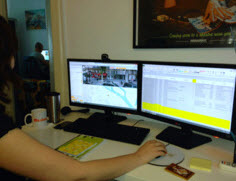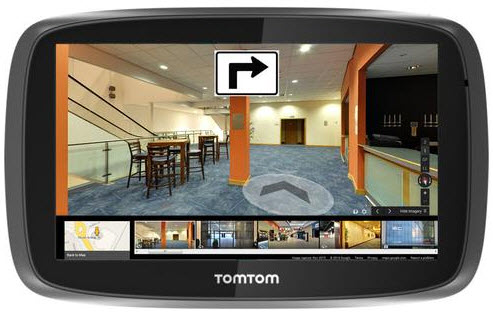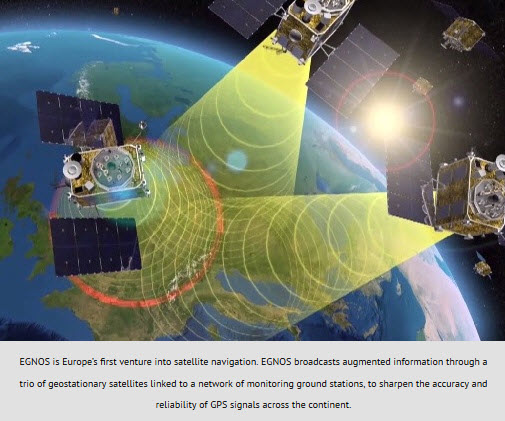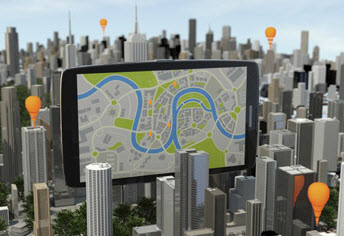The Airport and Mall Indoor Location Dilemma
15 September 2014
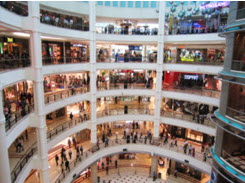
Executive Summary
With the advent of iOS 8 next month, and the increased presence of Wi-Fi and Bluetooth beacons that can be used to improve the fidelity of indoor location, Apple are inviting venues such as malls and airports to sign over the rights to map the insides of their facilities. They join Google who offer venues the opportunity to upload the floor plans of their venues and provide a crowd sourced app to survey the property.
Venue owners have tough decisions to make. Indoor mapping will enable major benefits for the shoppers using their facilities. Visitors will be able to find the products and facilities they want more conveniently through an array of third party apps and most significantly through Apple and Google’s Maps programs.
Unless the venue owners coordinate their actions and negotiate a share of the digital revenues that Apple and Google can derive from these rights, they will find themselves forever cut out of a digital revenue stream that they will be underwriting with their capital investments in bricks and mortar, Wi-Fi routers and beacon hardware.
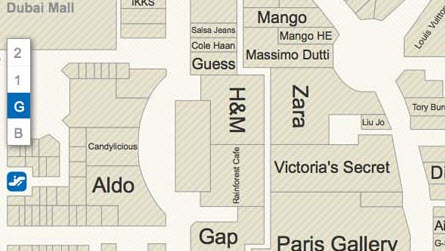
The Question
What do you do if you own the P&L for a mall or an airport and you get an offer from Google or Apple to enable indoor location in your venue? “Your customer’s experience will be enhanced. We can drive more visits to your concessions. This will drive more sales for your concessionaires. Just sign here.”
Metaphorically, the gold pen rolls across the desk, like something out of a scene from Glen Garry Glen Ross. Will the venue owner be able to resist the temptation to catch that pen and sign before they can think the decision through? What are they really buying, or more accurately, giving away? It’s a big decision. Like the proverbial genie in the bottle, once out, it’s hard to get it back in. If enough of the of the venue owners sign, those that try to hold out may be forced to give up their rights and sign whether they like it or not.
This is more than a theoretical question. Bluetooth beacons are on the verge of significantly improving the accuracy of indoor location and with iOS 8’s enhanced indoor positioning Core Location API about to be released next month, it’s a question that confronts leaders of all those businesses today. Apple extended their invitation to venue owners at this year’s developer conference WWDC14. Venue owners can request information about the Apple program at mapsconnect.apple.com and from Google at www.google.com/maps/about/partners/indoormaps/
It’s a strategic question that requires gaming out a number of scenarios and guessing at a set of cards that have not been revealed or even dealt yet. It also potentially requires some coordinated action between those organizations to avoid being steamrollered into a situation where they give up a lot of potential revenue to the mobile OS vendors.
Big Deal?
Make no mistake this is a big deal for Google and Apple. Google and Apple are similarly positioned in terms of their assets, although clearly Google is the one that is reliant on their advertising revenue. Apple is not totally divorced from the ad business (see iAd). Looking at the investment and pain that Apple has sucked up and pushed through during the initial reception of its Maps offering, its clear this area is strategic. So don’t expect offers to be forthcoming from Google to share in its lifeblood.
hat said it could be argued there is precedent for a revenue share. If you host a web site and you add a space for AdSense targeted ads to the site you are compensated. In the advertising vernacular you are creating inventory. In the world of digital to physical convergence, the venue owner is doing the same thing by placing Bluetooth beacons and an adequate density of Wi-Fi access points in their venue.
Its not just the ad revenue that could be shared. Google charges fees to developers that include its maps in their application and use the Google Maps API for Business. Apple will likely make the argument to “trust me”. They aren’t Google and don’t have a business in the area of selling context-triggered ads, so why should they contemplate a business that doesn’t even exist in this agreement?
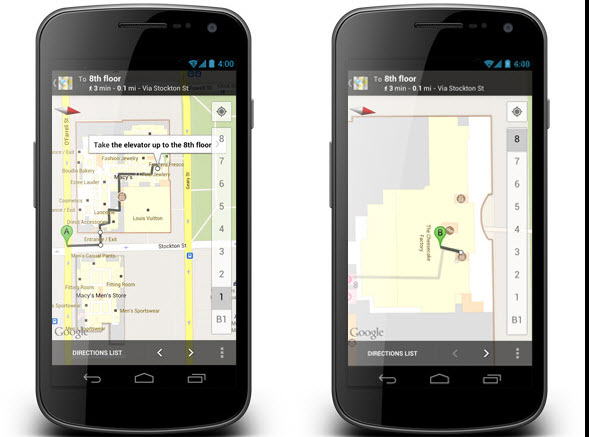
Apple University New Hire training must surely include a module on how to deflect discussions of unannounced products. So expect a riff on that, but they don’t have to get really specific about the revenue share, just agree to the principle of negotiating a share, if they do start to monetize this area. If they never intend to move into this area, that’s an easy thing to agree. We have seen Apple move into and dominate major new lines of business (music / phones!) that were foreign previously. It doesn’t always work out well for the traditional incumbents. Many of us expect them to move into mobile wallet with the iPhone 6. That’s a perfect place to use indoor location of offer context based ads.
The Offering: Today vs Tomorrow
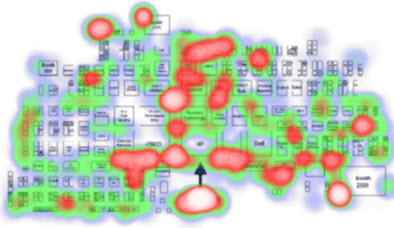
While Google’s offering has a lead (the Apple team would claim they have a lead in enabling multiple floors in their indoor model), it’s important to understand what Apple have announced now, versus what is likely to follow. What is currently on the table is relatively limited and innocuous; it’s the open-ended commitment that is the dangerous thing.
All Apple have announced today is a program that will enhance the accuracy of their Core Location API. The venue owner provides scaled CAD drawings of their property and permits a survey with an app that uses a number of the phone’s sensors and radios, including Wi-Fi to map out the indoor signatures that will enable better positioning. There is no direct reference to Bluetooth beacons. Apple characterize the role of the beacon more as a trigger for proximity events, but beacons can be used to triangulate and infer more accurate positioning if their location remains static. You can afford to install more Bluetooth beacons for these purposes than Wi-Fi access points, so the beacon is of particular significance going forward. This API enables any third party application that needs to establish the floor number, latitude and longitude of a user, be it apps from a mall or airport, a retailer’s app, a brand’s app, airline apps, shopping or travel apps.
At a certain point, support for enhanced indoor positioning by airports could become a required facility, expected by all passengers, similar to the provision of Wi-Fi. Imagine if United Airlines were to start to offer prompts to travelers who are at the wrong place at the wrong time. If a traveler is mistakenly waiting at the wrong gate, or in a lounge when they should be at their departure gate, the traveller would welcome an alert telling them that they need to move or miss their next flight. Then imagine if this service works at some airports and not others. The pressure that will be applied to airports that haven’t enabled this function could force them to forgo the revenue opportunity.
The OS vendors are in a very strong negotiating position, but compliance isn’t inevitable. Last time we saw anything like this was when major retailers rejected Google Wallet, in order to prevent Silicon Valley extracting value out of their stores without getting their fair share. Retailers are already wary of scenarios like this, but will the mall and airport owners have the same resolve?
What’s so Special about Airports?

While the indoor location question confronts many venue owners, including hospitals, theme parks and ballparks, it’s a huge deal for malls and airports because, that’s where the biggest pot of gold is. The top 20 US airports hosted over 900 million passenger visits in total last year.
The top 20 Shopping malls hosted roughly half that number, granted there are a lot more malls than airports.
A top tier sports venue, such as Madison Square Gardens that houses multiple sports teams as well as concerts and other gatherings, hosts 4 million visitors a year, the largest airports can see 20 times that traffic. Airports are very similar to malls in that they provide facilities for multiple merchants and deliver large numbers of consumers ready to spend significant dollars. Typically an airport will charge for the square footage they provide the concessions and in addition receive some kind of revenue share from the sales that the retailer closes. Given that relationship, a lift in revenues from merchants could result when shoppers are targeted by indoor location based promotions. Apple and Google can therefore argue that the malls and airports sole benefit should be the increase in revenues that they may realize.
Value to the Visitor
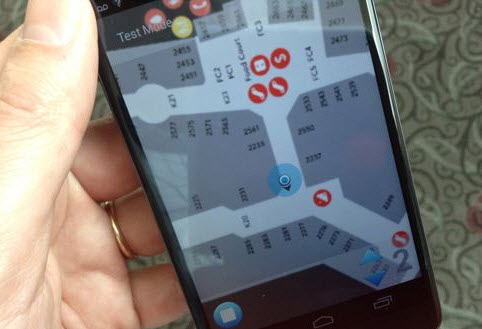
The value to those consumers who see past the privacy concerns of sharing their location is very attractive. Who doesn’t want better indoor positioning on their phone? From finding products you want, to locating the nearest amenity, be it a ticket counter, gate or toilet, it would be great to be able to use Apple or Google maps to find all that. There lies part of the problem. Already some venue owners are turning over the keys to their castle to the mobile OS companies. San Jose Airport is the example Apple have used as the first mover in this space. For Google, it’s San Francisco Airport. This will inevitably result in some pressure for the venues to compete in offering this convenience.
Conditional Access
Venue owners are already experimenting with deploying these beacons to trigger locations. Many are choosing to do this with beacons that go beyond the Apple’s current iBeacon standard and implement a conditional access layer, e.g. Gimbal, inMarket and Swirl. Typically these beacons obfuscate the identity of the beacon by rolling the codes that are broadcast so they change regularly. The resolution of these rolling codes is done via a cloud service, such that authorized applications can make sense of the numbers and unauthorized apps see a stream of numbers that do not allow for a mapping between the beacon ID and a particular location. This is done so as to avoid apps, such as Amazon’s, from using this more accurate location information to “showroom” (e.g. knowing you are in Best Buy’s TV department, pushing offers that would persuade you to buy online at Amazon).
Even in its current form, the more accurate Core Location API potentially opens up that danger. Amazon’s app could detect that a shopper is at Brookstones and Amazon could push competitive offers. Apple could resolve this issue in the future by annexing this conditional access function into their API. This would make sense, as it enables a pay-to-play model that they could control, extracting revenue from the app developers that want this kind of access. In that scenario, the question is, would they share that value with the venue owner and the beacon owner. That’s a card that has yet to be played. In the meantime, venue owners and retailers are best advised to keep access to their beacons locked down with conditional access, using this as an important card in their negotiations.
Maps, the Ultimate Shopping App
Another card that has yet to be played, but surely will be, is for Apple Maps to use the enhanced fidelity of the Core Location API and provide more detailed information about an individual’s surroundings than it already does. Apple Maps could then show the stores and other facilities that are nearby in a mall or airport. Observers may assume that because the Core Location API is now “indoor enabled” that Apple Maps will fully leverage that capability. Apple are clear that is not necessarily the case. Most venue owners who have produced their own apps, must reluctantly accept that only a small fraction of their guests will ever download and use that app. Nearly all of them will use Apple or Google Maps. Apple may not have announced its support for indoor location information in their Maps products out of concern that they have yet to achieve adequate coverage of indoor venues in an area they know is under heavy scrutiny ever since its inauspicious launch.
Another argument that Apple and Google may make is that the revenue from triggering mobile ads and coupons isn’t significant. Given the traffic levels, the value of the products being promoted and the moneyed audience that can be targeted, this doesn’t stand up.
About the Author
Stephen Statler is the principal consultant at Statler Consulting. Previously he worked at Qualcomm (the world's largest provider of mobile semiconductors) for 7 years, most recently as Senior Director, where he led the Qualcomm Retail Solutions team’s Strategy and Solutions Management groups, helping to chart the direction of the division, developing new offerings and providing consulting services. Qualcomm Retail Solutions was the the division that took Qualcomm's Gimbal Bluetooth beacon and context platform to market. Steve worked as part of the team developing and marketing that solution, gaining perspective on the beacon ecosystem from the inside of one of the leading manufacturers of beacon hardware. He also collaborated with external beacon ecosystem players in particular on applications for payments, unattended retail (vending), air transportation and the petroleum verticals, developing first hand experience of the opportunities and issues with deploying beacon technology in real world environments.
Prior to that he has worked at IBM, Passage, a spinout/start-up from Intel and a number of other high tech companies, in marketing, engineering, sales and consulting services. Further details can be found at www.linkedin.com/in/stevestatler/
Disclaimer: The opinions expressed herein are the personal opinions of the author and are not necessarily those of GPS Business News.
Stephen Statler, Statler Consulting
Source
With the advent of iOS 8 next month, and the increased presence of Wi-Fi and Bluetooth beacons that can be used to improve the fidelity of indoor location, Apple are inviting venues such as malls and airports to sign over the rights to map the insides of their facilities. They join Google who offer venues the opportunity to upload the floor plans of their venues and provide a crowd sourced app to survey the property.
Venue owners have tough decisions to make. Indoor mapping will enable major benefits for the shoppers using their facilities. Visitors will be able to find the products and facilities they want more conveniently through an array of third party apps and most significantly through Apple and Google’s Maps programs.
Unless the venue owners coordinate their actions and negotiate a share of the digital revenues that Apple and Google can derive from these rights, they will find themselves forever cut out of a digital revenue stream that they will be underwriting with their capital investments in bricks and mortar, Wi-Fi routers and beacon hardware.

The Question
What do you do if you own the P&L for a mall or an airport and you get an offer from Google or Apple to enable indoor location in your venue? “Your customer’s experience will be enhanced. We can drive more visits to your concessions. This will drive more sales for your concessionaires. Just sign here.”
Metaphorically, the gold pen rolls across the desk, like something out of a scene from Glen Garry Glen Ross. Will the venue owner be able to resist the temptation to catch that pen and sign before they can think the decision through? What are they really buying, or more accurately, giving away? It’s a big decision. Like the proverbial genie in the bottle, once out, it’s hard to get it back in. If enough of the of the venue owners sign, those that try to hold out may be forced to give up their rights and sign whether they like it or not.
This is more than a theoretical question. Bluetooth beacons are on the verge of significantly improving the accuracy of indoor location and with iOS 8’s enhanced indoor positioning Core Location API about to be released next month, it’s a question that confronts leaders of all those businesses today. Apple extended their invitation to venue owners at this year’s developer conference WWDC14. Venue owners can request information about the Apple program at mapsconnect.apple.com and from Google at www.google.com/maps/about/partners/indoormaps/
It’s a strategic question that requires gaming out a number of scenarios and guessing at a set of cards that have not been revealed or even dealt yet. It also potentially requires some coordinated action between those organizations to avoid being steamrollered into a situation where they give up a lot of potential revenue to the mobile OS vendors.
Big Deal?
Make no mistake this is a big deal for Google and Apple. Google and Apple are similarly positioned in terms of their assets, although clearly Google is the one that is reliant on their advertising revenue. Apple is not totally divorced from the ad business (see iAd). Looking at the investment and pain that Apple has sucked up and pushed through during the initial reception of its Maps offering, its clear this area is strategic. So don’t expect offers to be forthcoming from Google to share in its lifeblood.
hat said it could be argued there is precedent for a revenue share. If you host a web site and you add a space for AdSense targeted ads to the site you are compensated. In the advertising vernacular you are creating inventory. In the world of digital to physical convergence, the venue owner is doing the same thing by placing Bluetooth beacons and an adequate density of Wi-Fi access points in their venue.
Its not just the ad revenue that could be shared. Google charges fees to developers that include its maps in their application and use the Google Maps API for Business. Apple will likely make the argument to “trust me”. They aren’t Google and don’t have a business in the area of selling context-triggered ads, so why should they contemplate a business that doesn’t even exist in this agreement?

Apple University New Hire training must surely include a module on how to deflect discussions of unannounced products. So expect a riff on that, but they don’t have to get really specific about the revenue share, just agree to the principle of negotiating a share, if they do start to monetize this area. If they never intend to move into this area, that’s an easy thing to agree. We have seen Apple move into and dominate major new lines of business (music / phones!) that were foreign previously. It doesn’t always work out well for the traditional incumbents. Many of us expect them to move into mobile wallet with the iPhone 6. That’s a perfect place to use indoor location of offer context based ads.
The Offering: Today vs Tomorrow

While Google’s offering has a lead (the Apple team would claim they have a lead in enabling multiple floors in their indoor model), it’s important to understand what Apple have announced now, versus what is likely to follow. What is currently on the table is relatively limited and innocuous; it’s the open-ended commitment that is the dangerous thing.
All Apple have announced today is a program that will enhance the accuracy of their Core Location API. The venue owner provides scaled CAD drawings of their property and permits a survey with an app that uses a number of the phone’s sensors and radios, including Wi-Fi to map out the indoor signatures that will enable better positioning. There is no direct reference to Bluetooth beacons. Apple characterize the role of the beacon more as a trigger for proximity events, but beacons can be used to triangulate and infer more accurate positioning if their location remains static. You can afford to install more Bluetooth beacons for these purposes than Wi-Fi access points, so the beacon is of particular significance going forward. This API enables any third party application that needs to establish the floor number, latitude and longitude of a user, be it apps from a mall or airport, a retailer’s app, a brand’s app, airline apps, shopping or travel apps.
At a certain point, support for enhanced indoor positioning by airports could become a required facility, expected by all passengers, similar to the provision of Wi-Fi. Imagine if United Airlines were to start to offer prompts to travelers who are at the wrong place at the wrong time. If a traveler is mistakenly waiting at the wrong gate, or in a lounge when they should be at their departure gate, the traveller would welcome an alert telling them that they need to move or miss their next flight. Then imagine if this service works at some airports and not others. The pressure that will be applied to airports that haven’t enabled this function could force them to forgo the revenue opportunity.
The OS vendors are in a very strong negotiating position, but compliance isn’t inevitable. Last time we saw anything like this was when major retailers rejected Google Wallet, in order to prevent Silicon Valley extracting value out of their stores without getting their fair share. Retailers are already wary of scenarios like this, but will the mall and airport owners have the same resolve?
What’s so Special about Airports?

While the indoor location question confronts many venue owners, including hospitals, theme parks and ballparks, it’s a huge deal for malls and airports because, that’s where the biggest pot of gold is. The top 20 US airports hosted over 900 million passenger visits in total last year.
The top 20 Shopping malls hosted roughly half that number, granted there are a lot more malls than airports.
A top tier sports venue, such as Madison Square Gardens that houses multiple sports teams as well as concerts and other gatherings, hosts 4 million visitors a year, the largest airports can see 20 times that traffic. Airports are very similar to malls in that they provide facilities for multiple merchants and deliver large numbers of consumers ready to spend significant dollars. Typically an airport will charge for the square footage they provide the concessions and in addition receive some kind of revenue share from the sales that the retailer closes. Given that relationship, a lift in revenues from merchants could result when shoppers are targeted by indoor location based promotions. Apple and Google can therefore argue that the malls and airports sole benefit should be the increase in revenues that they may realize.
Value to the Visitor

The value to those consumers who see past the privacy concerns of sharing their location is very attractive. Who doesn’t want better indoor positioning on their phone? From finding products you want, to locating the nearest amenity, be it a ticket counter, gate or toilet, it would be great to be able to use Apple or Google maps to find all that. There lies part of the problem. Already some venue owners are turning over the keys to their castle to the mobile OS companies. San Jose Airport is the example Apple have used as the first mover in this space. For Google, it’s San Francisco Airport. This will inevitably result in some pressure for the venues to compete in offering this convenience.
Conditional Access
Venue owners are already experimenting with deploying these beacons to trigger locations. Many are choosing to do this with beacons that go beyond the Apple’s current iBeacon standard and implement a conditional access layer, e.g. Gimbal, inMarket and Swirl. Typically these beacons obfuscate the identity of the beacon by rolling the codes that are broadcast so they change regularly. The resolution of these rolling codes is done via a cloud service, such that authorized applications can make sense of the numbers and unauthorized apps see a stream of numbers that do not allow for a mapping between the beacon ID and a particular location. This is done so as to avoid apps, such as Amazon’s, from using this more accurate location information to “showroom” (e.g. knowing you are in Best Buy’s TV department, pushing offers that would persuade you to buy online at Amazon).
Even in its current form, the more accurate Core Location API potentially opens up that danger. Amazon’s app could detect that a shopper is at Brookstones and Amazon could push competitive offers. Apple could resolve this issue in the future by annexing this conditional access function into their API. This would make sense, as it enables a pay-to-play model that they could control, extracting revenue from the app developers that want this kind of access. In that scenario, the question is, would they share that value with the venue owner and the beacon owner. That’s a card that has yet to be played. In the meantime, venue owners and retailers are best advised to keep access to their beacons locked down with conditional access, using this as an important card in their negotiations.
Maps, the Ultimate Shopping App
Another card that has yet to be played, but surely will be, is for Apple Maps to use the enhanced fidelity of the Core Location API and provide more detailed information about an individual’s surroundings than it already does. Apple Maps could then show the stores and other facilities that are nearby in a mall or airport. Observers may assume that because the Core Location API is now “indoor enabled” that Apple Maps will fully leverage that capability. Apple are clear that is not necessarily the case. Most venue owners who have produced their own apps, must reluctantly accept that only a small fraction of their guests will ever download and use that app. Nearly all of them will use Apple or Google Maps. Apple may not have announced its support for indoor location information in their Maps products out of concern that they have yet to achieve adequate coverage of indoor venues in an area they know is under heavy scrutiny ever since its inauspicious launch.
Another argument that Apple and Google may make is that the revenue from triggering mobile ads and coupons isn’t significant. Given the traffic levels, the value of the products being promoted and the moneyed audience that can be targeted, this doesn’t stand up.
About the Author
Stephen Statler is the principal consultant at Statler Consulting. Previously he worked at Qualcomm (the world's largest provider of mobile semiconductors) for 7 years, most recently as Senior Director, where he led the Qualcomm Retail Solutions team’s Strategy and Solutions Management groups, helping to chart the direction of the division, developing new offerings and providing consulting services. Qualcomm Retail Solutions was the the division that took Qualcomm's Gimbal Bluetooth beacon and context platform to market. Steve worked as part of the team developing and marketing that solution, gaining perspective on the beacon ecosystem from the inside of one of the leading manufacturers of beacon hardware. He also collaborated with external beacon ecosystem players in particular on applications for payments, unattended retail (vending), air transportation and the petroleum verticals, developing first hand experience of the opportunities and issues with deploying beacon technology in real world environments.
Prior to that he has worked at IBM, Passage, a spinout/start-up from Intel and a number of other high tech companies, in marketing, engineering, sales and consulting services. Further details can be found at www.linkedin.com/in/stevestatler/
Disclaimer: The opinions expressed herein are the personal opinions of the author and are not necessarily those of GPS Business News.
Stephen Statler, Statler Consulting
Source


